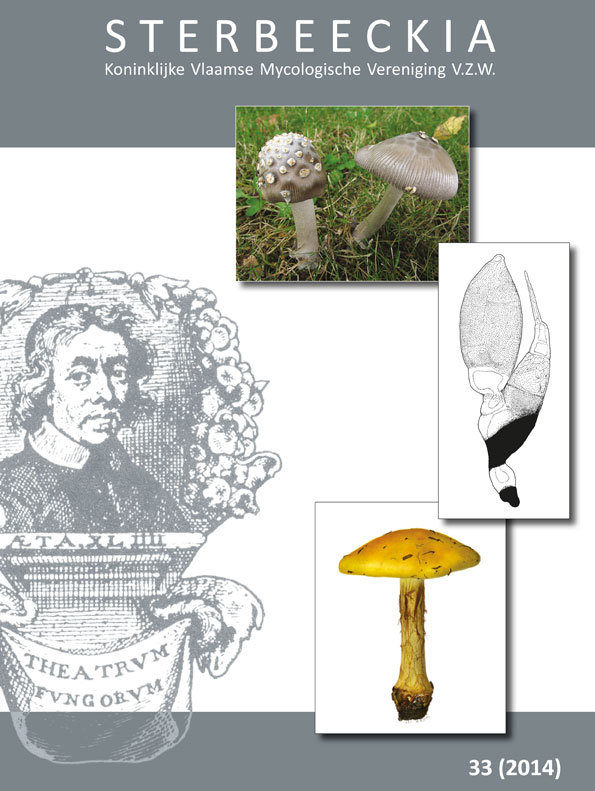| Inhoud |
Downloads per artikel onder rubriek Documentatie
Sterbeeckia 33: 3-8 (2014)
Amanita simulans, a species little known in Belgium, Fraiture A. & De Beuckeleer H.
Summary
Amanita simulans Contu has been collected in Stekene (Belgium). The specimens are briefly described and illustrated. A synthesis of the taxonomy and systematics of the species is presented. A. simulans remained unknown because it was confused with other (often ill-defined) taxa, such as Amanita vaginata, Amanita lividopallescens and “Amanita malleata”. The most important characteristics of A. simulans are presented and its ecology analysed. The presence of the species in Europe and, more precisely, in Belgium is examined. After having been ignored or misidentified up to recently, A. simulans has been repeatedly observed in Belgium for a few years.
Samenvatting
Amanita simulans Contu werd verzameld in Stekene (België). De exemplaren worden bondig beschreven en geïllustreerd. Een synthese van de taxonomie en de systematiek van de soort wordt besproken. A. simulans bleef onbekend omdat de soort werd verward met andere (vaak slecht gedefinieerde) taxa, zoals Amanita vaginata, Amanita lividopallescens en “Amanita malleata”. De voornaamste kenmerken van A. simulans worden besproken en de ecologie geanalyseerd. Het voorkomen van de soort in Europa en meer bepaald in België wordt onderzocht. Tot voor kort werd A. simulans miskend of foutief gedetermineerd, maar sedert enkele jaren herhaaldelijk waargenomen in België.
Sterbeeckia 33: 9-15 (2014)
Belgian records of Laboulbeniales from aquatic insects (3) – species from Dryops luridus, De Kesel A. & Haelewaters D.
Summary
Data and illustrations are presented on Cantharomyces denigratus, Cantharomyces italicus, and Helodiomyces elegans. All three taxa are new for Belgium and were exclusively found on the aquatic beetle Dryops luridus (Coleoptera, Dryopidae). Although the parasites can occur simultaneously on a single host specimen, the two species of Cantharomyces show a distinctive distribution pattern on male and female hosts. The gender related infection pattern of Cantharomyces denigratus cannot be explained by copulation of the host. Two opposing hypothesis are given as to whether C. denigratus and C. italicus should be considered conspecific. A lectotype for C. denigratus is indicated.
Samenvatting
Dit artikel presenteert gegevens en illustraties van Cantharomyces denigratus, Cantharomyces italicus en Helodiomyces elegans. Deze drie parasieten zijn nieuw voor België en werden uitsluitend gevonden op de waterkever Dryops luridus (Coleoptera, Dryopidae). Hoewel de drie soorten tegelijkertijd kunnen voorkomen op één individu, vertonen beide Cantharomyces soorten een matig tot sterk verschillend distributiepatroon op de mannelijke en vrouwelijke gastheer. Cantharomyces denigratus vertoont een infectiepatroon dat niet verklaard kan worden door transmissie tijdens copulatie van de gastheren. Twee hypothesen worden gegeven om te verklaren of C. denigratus en C. italicus twee aparte soorten zijn of eerder groeivormen van slechts één soort.
Sterbeeckia 33: 16-23 (2014)
Bijdrage tot de kennis van het subgenus Telamonia (Cortinarius) in België (19), de Haan A., Volders J., Gelderblom J., Verstraeten P. & Van de Kerckhove O.
Summary
In this nineteenth report by the Cortinarius study-group of the “Koninklijke Vlaamse Mycologische Vereniging” full descriptions, illustrations and discussions are given of Cortinarius disjungendus P. Karst., Cortinarius ignotissimus Bidaud and Cortinarius bulbosus Fr.
Sterbeeckia 33: 24-40 (2014)
Het subgenus Phlegmacium (Cortinarius) in Vlaanderen (1), Verstraeten P., de Haan A., Volders J., Gelderblom J. & Van de Kerckhove O.
Summary
In this first report on the subgenus Phlegmacium (Cortinarius) by the Cortinarius study-group of the “Koninklijke Vlaamse Mycologische Vereniging” full descriptions, illustrations and discussions are given of Cortinarius cisticola T.G. Frøslev & T.S. Jeppesen, Cortinarius coalescens Kärcher & Seibt, Cortinarius subpurpurascens (Batsch) Fr., Cortinarius xanthoochraceus P.D. Orton and Cortinarius elegantissimus Rob. Henry.
Samenvatting
In dit eerste verslag wordt een beknopte situering van het subg. Phlegmacium (Fr.) Trog geschetst, worden materiaal en gebruikte methodes aangegeven en vervolgens 5 collecties beschreven, verzameld in 2013, nl.: Cortinarius cisticola T.G. Frøslev & T.S. Jeppesen, Cortinarius coalescens Kärcher & Seibt, Cortinarius subpurpurascens (Batsch) Fr., Cortinarius xantho-ochraceus P.D. Orton en Cortinarius elegantissimus Rob. Henry.
Sterbeeckia 33: 41-44 (2014)
Basidiemorfologie bij Dacrymyces, Van De Put K.
Summary
Observations on the morphology of the basidia in the genus Dacrymyces (Dacrymycetales) are discussed and interpreted in this paper. In particular the differences in structure of the probasidia apex, caused by the implantation of the sterigmata. These differences can help to distinguish the species in the Dacrymyces s.l.-complex, i.e. D. stillatus Nees, D. capitatus Schwein. and D. minor Peck. Dacrymyces stillatus has sterigmata that are mostly laterally implanted, a central insertion is frequently observed in D. minor and D. capitatus shows an intermediate position. By using these characteristics it is
possible to distinguish three different basidial types, schematically marked as “W”, ”U” and “V”. Micrographs are given of the three types. The author argues that the frequently used name Dacrymyces lacrymalis (Pers.) Sommerf. should be abandoned and considered a synonym of D. capitatus.
Samenvatting
Hoewel er weinig aandacht wordt besteed aan de morfologie van de basidiën bij het genus Dacrymyces zijn er in het Dacrymyces s.l.-complex met D. stillatus Nees, D. capitatus Schwein. en D. minor Peck toch duidelijke verschillen bij de basidiën, voornamelijk te wijten aan de inplantingsplaats van de sterigmen aan de apex van de probasidiën. Zo staan de sterigmen bij D. stillatus het meest lateraal, bij D. minor overwegend centraal en bij D. capitatus intermediair ingeplant. Op die manier kan men de verschillende types (“W”, ”U” en “V” in het artikel) duidelijk onderscheiden. In dit complex is de nog veel gebruikte naam Dacrymyces lacrymalis (Pers) Sommerf. te mijden en te beschouwen als synoniem van D. capitatus.
|

